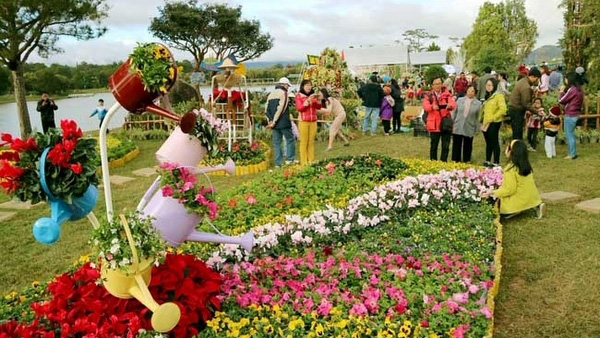


|
At the 2017 Da Lat Flower Festival Located at an altitude of more than 1.400 metres above sea
level and having temperate weather (around 18 – 20 degree celsius), Da Lat is
considered as a ‘small Paris’ with fine forests and vibrant colours from
thousands of kinds of flowers.
During the seventh Da Lat Flower Festival in December 2017,
a visitor from Ho Chi Minh City used the phrase ‘Vietnam’s terrace’ for the
city. It means that Da Lat is a prosperous land with flower plantations, as
well as being a place for people to relax and forget the sorrow in their
lives.
In 1893, scientist Alexandre Émile Jean Yersin discovered
Da Lat and the French people embarked on building the place in a resort city
over the next years. An agricultural station was formed in 1898 to research
and experiment with plant species, including many varieties of flowers. After
the research work, it was found that flowers from France and temperate zones
were suitable to be grown on Lang Biang mountain.
Farmers from the north made great contributions to turning
the plateau city into a ‘land of flowers’. In 1938, under the Nguyen Dynasty,
33 farmers from flower villages in Ha Dong province (now Hanoi), including
Nghi Tam, Quang Ba, Van Phuc and Tay Tu, were invited by Emperor Bao Dai to
use their plantation for flowers. After that, people from Ha Tinh, Nghe An,
Quang Ngai and Thua Thien – Hue moved to Da Lat and became familiar with
flower cultivation. As a result, the long-history of the flower villages,
such as Ha Dong, Nghe Tinh, Thai Phien and Da Thanh hamlets, were formed.
Visiting Da Lat, visitors were very impressed by the
thousands of kinds of flowers there. In addition to the flowers planted by
people in parks, offices and gardens, the city has become famous for numerous
beautiful wild flowers. They grew on the sides of the streets and in jungles,
as well as clinging to the cliffs on the hillsides or the walls, creating a
green beauty in the ‘flower city’. Flowers, nature and the misty atmosphere
were the invisible strings making people from different regions become attached
to this peaceful land.
Interestingly, local people here are fond of growing
flowers by themselves in order to make their living spaces more beautiful.
Over the past 100 years, many people throughout the generations have been
industrious and ingenious in caring for the flower gardens in Hanoi,
contributing to providing beautiful moments to flower lovers from all regions
around the country. Currently, Da Lat leads the country on the area, quality
and diversification of the varieties of flowers.
Over the years, flower plantations have changed throughout
the country’s history. In the past, Da Lat people grew flowers to make their
houses and streets more beautiful or to serve restaurants and hotels.
However, nowadays, flowers are the main products for them to earn living. The
city became a huge flower garden. Da Lat’s flowers are now available in most
of localities in the country, as well as in other countries around the world.
High technology has been applied in growing flowers in Da
Lat. Notably, Dalat Hasfarm company has become well-known in producing
flowers of high class. Its products have been exported to numerous major
markets in the world, including Japan, Hong Kong (China), the UK, Australia
and Thailand. In addition, other enterprises, such as Nong Ich, Lam Thang,
Ponifarm and Rung Hoa (Forest of Flowers), or the farms of Tran Huy Duong,
Che Quang De, Phan Thanh Sang and Nguyen Xuan Truong, are affirming their
position and brands. Many ethnic minority households have been successful in
planting flowers using high technology.
Flowers, along with other commodities including vegetables,
Arabica coffee and agricultural tourism, have become the four key products in
the international brand chain named ‘Da Lat – the essence of a good land’
which are built by the Lam Dong province under the support of the Japan
International Cooperation Agency.
The Da Lat Flower Festival has been held biennially since
2004, featuring diverse and large-scale events. In 2009, the Government
recognised Da Lat as a ‘City of Flower Festival’. Each festival has been a
showcase of ‘the flower culture’ in the plateau city. The festivals have
conveyed messages of the pride and unique values of the beautiful urban area,
as well as the gentleness and elegance of the local people on the Lam Vien
plateau.
The festivals have offered opportunities for the Lam Dong
provincial government to promote the image of the nature and people in the
‘land of thousands of flowers’ and Vietnam’s terrace to both domestic and
foreign visitors.
|
Source: NDO